论新闻英语词汇中新词的翻译策略
经济新闻英译中的翻译问题及对策——以诺德文本分析为指导
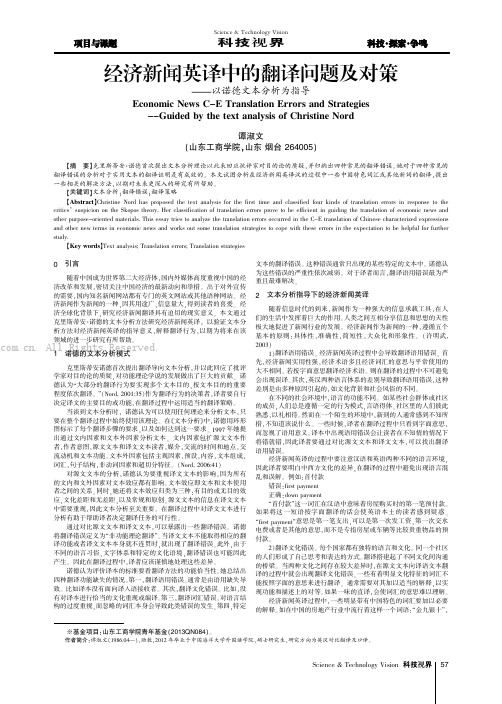
Science &Technology Vision 科技视界※基金项目:山东工商学院青年基金(2013QN084)。
作者简介:谭淑文(1986.04—),助教,2012年毕业于中国海洋大学外国语学院,硕士研究生,研究方向为英汉对比翻译及口译。
0引言随着中国成为世界第二大经济体,国内外媒体高度重视中国的经济改革和发展,密切关注中国经济的最新动向和举措。
出于对外宣传的需要,国内知名新闻网站都有专门的英文网站或其他语种网站。
经济新闻作为新闻的一种,因其用途广,信息量大,得到读者的喜爱。
经济全球化背景下,研究经济新闻翻译具有迫切的现实意义。
本文通过克里斯蒂安·诺德的文本分析方法研究经济新闻英译,以验证文本分析方法对经济新闻英译的指导意义,解释翻译行为,以期为将来在该领域的进一步研究有所帮助。
1诺德的文本分析模式克里斯蒂安诺德首次提出翻译导向文本分析,并以此回应了批评学家对目的论的质疑,对功能理论学说的发展做出了巨大的贡献。
诺德认为“大部分的翻译行为要实现多个文本目的,按文本目的的重要程度依次翻译。
”(Nord,2001:35)作为翻译行为的决策者,译者要自行决定译文的主要目的或功能,在翻译过程中运用适当的翻译策略。
当谈到文本分析时,诺德认为可以使用任何理论来分析文本,只要在整个翻译过程中始终使用该理论。
在《文本分析》中,诺德用环形图标示了每个翻译步骤的要求,以及如何达到这一要求。
1997年她提出通过文内因素和文本外因素分析文本。
文内因素包扩源文文本作者,作者意图,源文文本和译文文本读者,媒介,交流的时间和地点,交流动机和文本功能。
文本外因素包括主观因素,预设,内容,文本组成,词汇,句子结构,非动词因素和超切分特征。
(Nord,2006:41)对源文文本的分析,诺德认为要重视译文文本的影响,因为所有的文内和文外因素对文本效应都有影响。
文本效应即文本和文本使用者之间的关系。
同时,她还将文本效应归类为三种:有目的或无目的效应,文化差距和无差距,以及常规和原创。
英语娱乐新闻的语言特点及其翻译策略
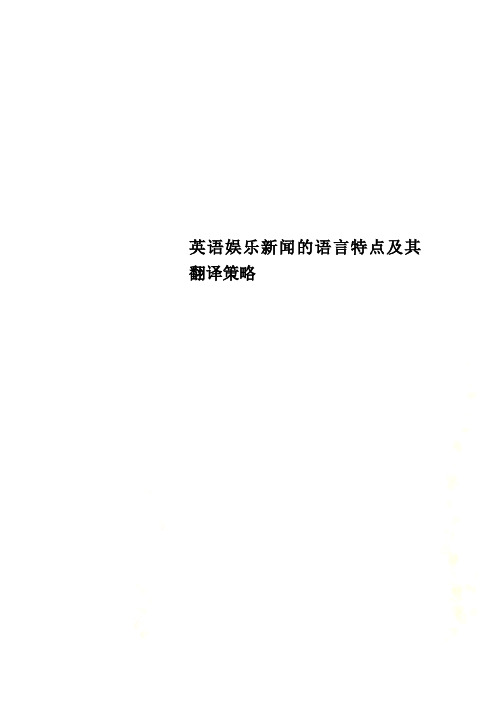
英语娱乐新闻的语言特点及其翻译策略英语娱乐新闻的语言特点及其翻译策略周熔英语翻译121班 12133225摘要英语娱乐新闻以其轻松愉快的报道方式和幽默简朴的语言特色吸引了成千上万的读者,他在用词造句和翻译方式等方面有着鲜明的特色。
本文从词汇特征,语法特征,时态特征以及翻译特征等方面来分析英语娱乐新闻的语言特色及其翻译策略,以帮助广大读者更好的理解和吸收英语娱乐新闻。
关键词英语娱乐新闻词汇特征语法特征翻译策略一、词汇特征英语娱乐新闻集现代英语之大成,涵盖范围广泛,内容丰富,如总统庄严的声明、民众轻松的谈话、各学科的术语、各领域的行话、风土人情甚至市井俚语,无所不包。
可以说,英语娱乐新闻是我们研究、掌握当代英语最直接的途径之一。
在长期的发展中英语娱乐新闻形成了以下几大词汇特征,即使用口语词、新词汇、外来词、缩略词和简缩词。
(一)口语词由于娱乐新闻非常贴近生活,因此其选词也较其他类型的新闻更加口语化。
口语化的词汇能使新闻读起来更加生动易懂,给读者带来轻松愉快的感受,更加吸引读者的眼球。
如:god works(上帝的安排)、not so bad(不错)、drop it(停止)、celebrity(名人)、debut(电影首次公映)、dub(电影配音)等。
(二)新词汇生活每天都在变,随着新事物的出现、新概念的发展以及时代的进步,新词汇也应运而生。
如:green food(绿色食品)、franchise(连锁店)、long time no see(好久不见)、local tyrant(土豪)、vomit slot(吐槽)等。
(三)外来词外来语反映了不同的文化联系,丰富了英语词汇,使英语更加国际化,了解英语外来语的发展过程、成因和来源,有利于加强对英语的理解。
在娱乐新闻中使用外来词,能使新闻更加国际化和内涵化。
如:hot pot(火锅)、Pinyin(汉语拼音)、yin and yang(阴阳)、tofu(豆腐)、Tai Chi(太极)、ramen(拉面)等。
中国特色新词英译现状及其翻译策略

中国特色新词英译现状及其翻译策略
中国特色新词英译现状及其翻译策略
随着中国的崛起和国际交流的增加,越来越多的中国特色新词汇被引
入到国际社会中。
然而,这些新词汇的英译却面临着一些挑战和困难。
首先,由于中国特色新词汇的独特性和文化背景,其英译往往需要考
虑到目标语言的文化差异和语言习惯。
例如,“中国梦”这一词汇在
英语中的翻译就需要考虑到西方文化中“梦想”的不同含义和表达方式。
其次,由于中国特色新词汇的创新性和时效性,其英译需要具备及时
性和准确性。
例如,“双11”这一词汇在中国的电商领域中非常流行,但其英译需要及时反映出其特定的时间和含义。
针对这些挑战和困难,翻译策略可以从以下几个方面入手:
1. 保持原汁原味。
对于一些具有独特文化背景和特定含义的中国特色
新词汇,可以考虑直接使用中文或拼音,以保持其原汁原味。
2. 适当注释。
对于一些较为复杂或具有多重含义的中国特色新词汇,
可以在翻译中适当加入注释或解释,以便读者更好地理解其含义和背景。
3. 创新翻译。
对于一些具有创新性和时效性的中国特色新词汇,可以采用创新的翻译方式,如直接使用拼音或创造新词汇等,以更好地反映其特定含义和时代背景。
总之,中国特色新词汇的英译需要考虑到其独特性和文化背景,采用适当的翻译策略,以更好地传递其含义和价值。
同时,随着中国的发展和国际交流的加强,我们也需要不断探索和创新,为中国特色新词汇的英译提供更好的解决方案。
新闻新词新语的英译研究
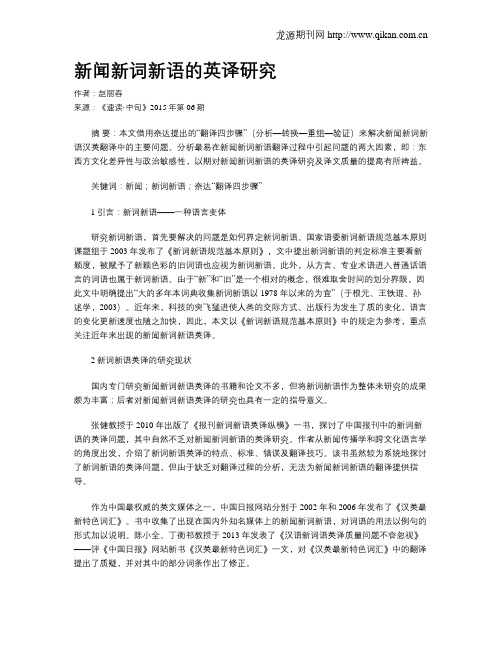
新闻新词新语的英译研究作者:赵丽春来源:《速读·中旬》2015年第06期摘要:本文借用奈达提出的“翻译四步骤”(分析—转换—重组—验证)来解决新闻新词新语汉英翻译中的主要问题。
分析最易在新闻新词新语翻译过程中引起问题的两大因素,即:东西方文化差异性与政治敏感性,以期对新闻新词新语的英译研究及译文质量的提高有所裨益。
关键词:新闻;新词新语;奈达“翻译四步骤”1引言:新词新语——一种语言变体研究新词新语,首先要解决的问题是如何界定新词新语。
国家语委新词新语规范基本原则课题组于 2003 年发布了《新词新语规范基本原则》,文中提出新词新语的判定标准主要看新颖度,被赋予了新颖色彩的旧词语也应视为新词新语。
此外,从方言、专业术语进入普通话语言的词语也属于新词新语。
由于“新”和“旧”是一个相对的概念,很难取舍时间的划分界限,因此文中明确提出“大的多年本词典收集新词新语以 1978 年以来的为宜”(于根元、王铁琨、孙述学,2003)。
近年来,科技的突飞猛进使人类的交际方式、出版行为发生了质的变化,语言的变化更新速度也随之加快,因此,本文以《新词新语规范基本原则》中的规定为参考,重点关注近年来出现的新闻新词新语英译。
2新词新语英译的研究现状国内专门研究新闻新词新语英译的书籍和论文不多,但将新词新语作为整体来研究的成果颇为丰富;后者对新闻新词新语英译的研究也具有一定的指导意义。
张健教授于 2010 年出版了《报刊新词新语英译纵横》一书,探讨了中国报刊中的新词新语的英译问题,其中自然不乏对新闻新词新语的英译研究。
作者从新闻传播学和跨文化语言学的角度出发,介绍了新词新语英译的特点、标准、错误及翻译技巧。
该书虽然较为系统地探讨了新词新语的英译问题,但由于缺乏对翻译过程的分析,无法为新闻新词新语的翻译提供指导。
作为中国最权威的英文媒体之一,中国日报网站分别于 2002 年和 2006 年发布了《汉英最新特色词汇》。
新闻英语的词汇特点及其翻译策略-讲义

总结:
新闻英语是重要的国际文化传媒,在 词汇运用上,新闻英语显示了不同于其他 文体的鲜明特色。在翻译新闻英语过程中, 译者应结合新闻英语的词汇特点,注重理 解的恰当无误以及表达的简洁和准确,这 样才能达到良好的效果。
2
新闻英语的词汇特点:
◆ 1. 小词(midget words),即简短词,一般 为单音节词。 e.g. Year's biggest fire guts 178 homes. 这里gut表示destroy completely by fire(火灾 毁坏)。
3
新闻英语的词汇特点:
◆ 2. 旧词新用是指有一定意义的词语由于词 性的转化或者词义的延伸而被赋予新的含义。 新闻报道常常使用“临时造次/生造词”, 即临时创造,或者是拼凑起来的词或词组。 e.g. Euro mart (European market—欧洲市场), haves and have-not (富人和穷人)。
精品
新闻英语的词汇特点及其翻译策略
新闻英语:
◆ 1. 新闻英语(Journalistic English),是指运 用于新闻报道、具有新闻特征、满足新闻报 道和新闻传播需求的英语。
◆ 2. 新闻报道常使用某些词汇来表示事实和事 件,因此这些新闻词汇经过长期使用后逐渐 取得与新闻报道相联系的特殊意义,成为新 闻体词汇(Journalistic Words)。
◆ e.g. This film is a remake. remake 多数情况下为动词,此处指”翻拍的电影“。
11
新闻英语汉译策略:
3. 首字母缩写词
(1) 在翻译时可以直接使用缩写词,即”省译“。 GDP: gross domestic product 国内生产总值 WB: world bank 世界银行
新闻新词新语的英译研究

新闻新词新语的英译研究【摘要】Conclusion:The research findings highlight the importance of accurate translations in news reporting. Limitations and future directions for research are also addressed, emphasizing the need for continued exploration of new translation techniques in journalism. Overall, the study contributes to a better understanding of translating new terms and expressions in news articles.【关键词】新闻新词新语、英译研究、引言、正文、结论、背景介绍、研究意义、研究目的、新闻中常见的新词新语、英译新词新语的方法、研究案例分析、影响因素探讨、应用前景展望、研究成果总结、不足与展望、未来研究方向1. 引言1.1 背景介绍With the rapid development of technology and the globalization of information, new words and phrases are constantly emerging in the news. These new terms often reflectthe latest trends, technologies, and social issues, making them crucial for understanding and interpreting current events. As a result, the study of new vocabulary in the news has become increasingly important in the field of language and communication.1.2 研究意义The study of new words and expressions in news reports plays a crucial role in understanding the evolving nature of language and communication in the modern world. With the rapid development of technology and globalization, new terms and phrases are constantly being introduced into the media landscape, reflecting the changing social, political, and cultural trends.1.3 研究目的Ultimately, the goal of this research is to anticipate the future trends and developments in news language, and to provide recommendations for effectively translating and incorporating new words and expressions in English-language news reporting. By examining the application prospects of these language innovations, we hope to contribute to the advancement of translation studies and communication practices in the news industry.2. 正文2.1 新闻中常见的新词新语新闻中常见的新词新语是指在新闻报道中频繁出现但在日常生活中较少使用的词汇和短语。
中国特色新词英译现状及其翻译策略

中国特色新词英译现状及其翻译策略一、本文概述随着中国的快速发展和国际地位的提升,中国特色新词的数量和影响力也在日益增强。
这些新词反映了中国社会的变迁、科技的进步以及文化的创新,为国际交流提供了丰富的词汇资源。
然而,如何准确、恰当地将这些新词翻译成英文,成为了当前翻译领域面临的一大挑战。
本文旨在探讨中国特色新词英译的现状及其翻译策略,以期为中国特色新词的英译提供有益的参考和启示。
本文将对中国特色新词的定义、来源和分类进行概述,明确研究范围和对象。
接着,通过分析当前中国特色新词英译的现状,揭示存在的问题和不足。
在此基础上,本文将深入探讨中国特色新词英译的翻译策略,包括直译、意译、音译、借译等多种方法,并结合具体案例进行分析和评价。
本文将对中国特色新词英译的未来发展趋势进行展望,提出相应的建议和思考。
通过本文的研究,旨在为中国特色新词的英译提供更为准确、规范和有效的翻译方法和策略,促进中国特色文化在国际舞台上的传播和交流。
也期望能够引起更多学者和翻译工作者的关注和研究,共同推动中国特色新词英译事业的发展。
二、中国特色新词的概念及分类中国特色新词,顾名思义,指的是那些具有中国文化特色、反映中国社会、经济、科技发展以及人民日常生活变化的新词汇。
这些词汇通常源于汉语的创新词汇、外来语的音译或意译、以及网络流行语等。
这些新词不仅反映了中国社会的快速发展和变迁,也丰富了汉语的词汇库,为语言的发展注入了新的活力。
创新词汇:这类词汇是基于汉语自身的构词规则和语义演变而产生的。
例如,“互联网+”“一带一路”“供给侧改革”等,这些词汇都是基于中国特有的政策、经济或社会现象而产生的。
外来语音译:随着中国与世界的交流日益频繁,许多外来词汇被引入汉语,并通过音译的方式转化为中文词汇。
例如,“咖啡”(coffee)、“披萨”(pizza)、“迪斯科”(disco)等。
外来语意译:除了音译外,许多外来词汇也被直接意译为中文,以保持其原有的含义。
英语新闻标题及其翻译策略

2 1 年 8月 00
赤 峰 学 院 学报 ( 文 哲 学社 会 科 学版 ) 汉
Junl f hf g n esy( c i orao in i ri S . ) C e U v t e S e
V0. 1 N . 13 o8
Au 2 0 g. 01
的 措词 不仪 能增 强新 闻 的 简 洁 性 和 可 读 性 ,而 且 还 能 美 化
如今 , 人们 了解信息 、 获取信 息往往要借 助媒 体手段 。 新闻报道作为信息传播 的主要途 径, 倍 受人们的青睐和关
注 。 在 国际 报 道 中 , 语 新 闻 占 了相 当 大 的 比重 , 标 题 又 英 而
忘 。 比 如 : r i l u p ’ o h o o c B t h ae E r e S p c o h l s词 “h c — is o t c i c oo
给新闻标题的翻译带来 了不少挑战 。这就要求译 者在了解
新闻标题特点的基础上 , 透过 字 面理 解 标 题 的 深 层 意 义 , 根
(e os ao ) o( si ) e(c o g) e . d m nt tn.hs opt ,t t nl y. t ri h 1 a ce o c
S naoa T o s C p Wi. est n hma u n il )中国队反败为胜荣 获汤姆斯
杯。
首字母缩略词。首字母缩略词就是利用词 的第一 个字 面代 表一 个词 组 的缩 略词 。一 个典 型 的例 子是 B C B .指 Bis r d at g C roao ( ri Bo csn oprln ̄国广播 公司) 其他常见的 th a i i 。
版面、 节约篇幅。 例如 :rj tb de i a d ie 通 过开 Po c r gsd l i d. e i st v 发让更 多的农村孩子接触 电脑 这项工程( 6 g = 1 n b de o —
英语新闻中的隐喻及翻译策略
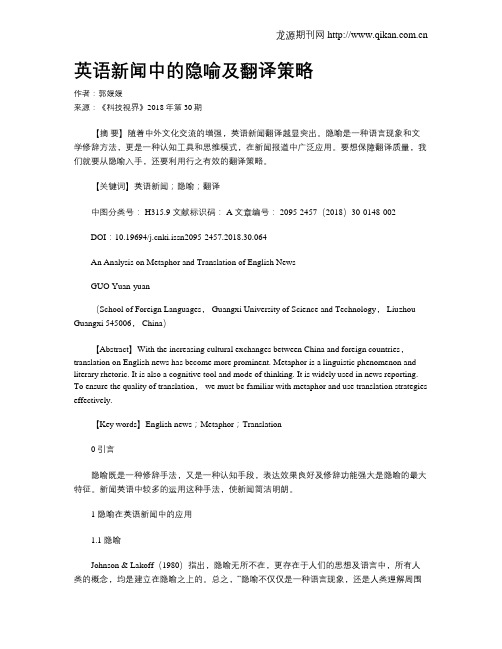
英语新闻中的隐喻及翻译策略作者:郭媛媛来源:《科技视界》2018年第30期【摘要】随着中外文化交流的增强,英语新闻翻译越显突出。
隐喻是一种语言现象和文学修辞方法,更是一种认知工具和思维模式,在新闻报道中广泛应用。
要想保障翻译质量,我们就要从隐喻入手,还要利用行之有效的翻译策略。
【关键词】英语新闻;隐喻;翻译中图分类号: H315.9 文献标识码: A 文章编号: 2095-2457(2018)30-0148-002DOI:10.19694/ki.issn2095-2457.2018.30.064An Analysis on Metaphor and Translation of English NewsGUO Yuan-yuan(School of Foreign Languages, Guangxi University of Science and Technology, Liuzhou Guangxi 545006, China)【Abstract】With the increasing cultural exchanges between China and foreign countries,translation on English news has become more prominent. Metaphor is a linguistic phenomenon and literary rhetoric. It is also a cognitive tool and mode of thinking. It is widely used in news reporting. To ensure the quality of translation, we must be familiar with metaphor and use translation strategies effectively.【Key words】English news;Metaphor;Translation0 引言隐喻既是一种修辞手法,又是一种认知手段,表达效果良好及修辞功能强大是隐喻的最大特征。
从中英新闻语言差异探究新闻的翻译方法

2472020年41期总第533期ENGLISH ON CAMPUS从中英新闻语言差异探究新闻的翻译方法文/丁 莉新闻标题也多使用单音词,甚至会将多音词简化为单音词或缩略语。
如“帮助”变为“助”,“吸引”变为“引”“中国企业”变为“中企”,“其他国家”变为“别国”,等等。
(2)导语。
英语新闻导语通常是一个句子,不超过35个单词,句意紧凑,较多使用名词和介词;汉语新闻导语则通常为2-3个句子,多用短句,句意松散,多使用动词。
英语新闻导语中,信息较为简洁,而汉语新闻导语的内容则相对详细。
汉语新闻导语常以时间、地点开头,然后介绍发生了何事。
英语新闻导语则通常以何事开头。
汉语新闻消息来源一般前置,英语新闻的消息来源,除非特别重要,否则一般后置。
可见,中英文新闻具有共同点,同时存在很多不同点,这就要求译者在翻译时,充分考虑到读者的阅读习惯进行翻译。
三、新闻翻译方法及实例翻译的基本原则是“信,达,雅”。
“‘信’指意义不悖原文;‘达’指不拘泥于原文形式,译文通顺明白;‘雅’则指译文时选用的词语要得体,追求文章本身的古雅,简明优雅。
”汉语属于汉藏语系,英语属印欧语系,存在诸多差异。
两种语言在语言结构、用词、构词等很多方面都不同。
因此在实际翻译过程中,会使用很多方法。
本文将这些方法加以总结,以典型和经典的实例加以论述和说明。
本文引用的新闻来源于《中国语日报》中文版和英文版及《参考消息》《环球时报》等,英语新闻素材均来自国外权威报纸机构,如the Washington Post, BBC, the Financial Times,the Wall Street Journal, Foreign Affairs, Foreign Policy, the NewYork Times, 等等。
1. 直译法。
直译是最基本的翻译策略,当英语的表达方式与汉语完全或基本相同时,在不影响准确达意、不破坏原文风格的前提下,可采用直译。
从信息释义角度谈外宣词汇翻译策略——以新词为例
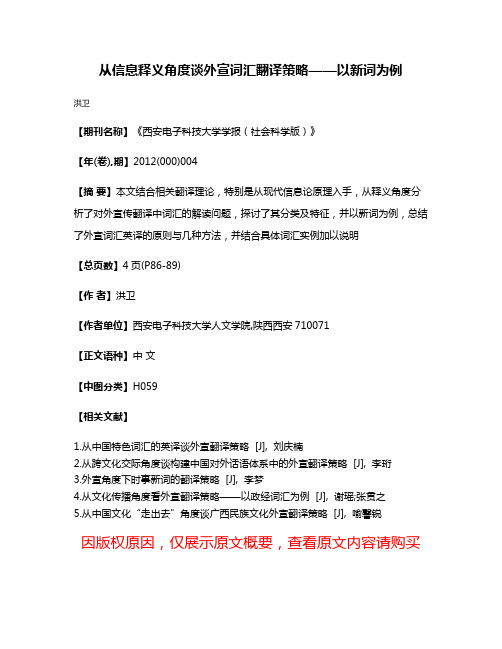
从信息释义角度谈外宣词汇翻译策略——以新词为例
洪卫
【期刊名称】《西安电子科技大学学报(社会科学版)》
【年(卷),期】2012(000)004
【摘要】本文结合相关翻译理论,特别是从现代信息论原理入手,从释义角度分析了对外宣传翻译中词汇的解读问题,探讨了其分类及特征,并以新词为例,总结了外宣词汇英译的原则与几种方法,并结合具体词汇实例加以说明
【总页数】4页(P86-89)
【作者】洪卫
【作者单位】西安电子科技大学人文学院,陕西西安710071
【正文语种】中文
【中图分类】H059
【相关文献】
1.从中国特色词汇的英译谈外宣翻译策略 [J], 刘庆楠
2.从跨文化交际角度谈构建中国对外话语体系中的外宣翻译策略 [J], 李珩
3.外宣角度下时事新词的翻译策略 [J], 李梦
4.从文化传播角度看外宣翻译策略——以政经词汇为例 [J], 谢瑶;张贯之
5.从中国文化“走出去”角度谈广西民族文化外宣翻译策略 [J], 喻馨锐
因版权原因,仅展示原文概要,查看原文内容请购买。
英语新词翻译特点及相对零翻译策略探析
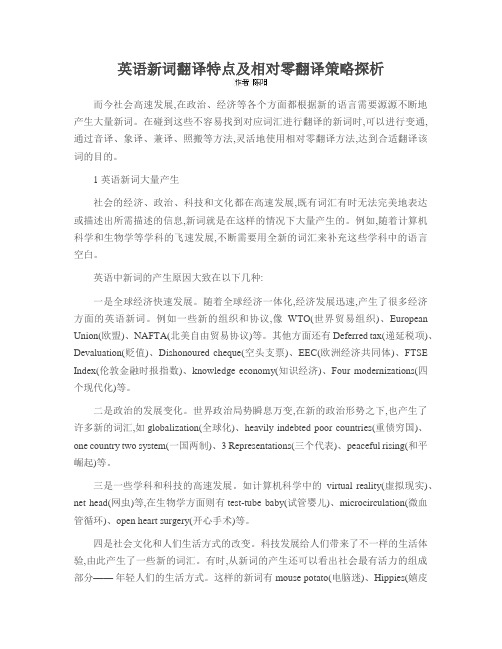
英语新词翻译特点及相对零翻译策略探析而今社会高速发展,在政治、经济等各个方面都根据新的语言需要源源不断地产生大量新词。
在碰到这些不容易找到对应词汇进行翻译的新词时,可以进行变通,通过音译、象译、兼译、照搬等方法,灵活地使用相对零翻译方法,达到合适翻译该词的目的。
1 英语新词大量产生社会的经济、政治、科技和文化都在高速发展,既有词汇有时无法完美地表达或描述出所需描述的信息,新词就是在这样的情况下大量产生的。
例如,随着计算机科学和生物学等学科的飞速发展,不断需要用全新的词汇来补充这些学科中的语言空白。
英语中新词的产生原因大致在以下几种:一是全球经济快速发展。
随着全球经济一体化,经济发展迅速,产生了很多经济方面的英语新词。
例如一些新的组织和协议,像WTO(世界贸易组织)、European Union(欧盟)、NAFTA(北美自由贸易协议)等。
其他方面还有Deferred tax(递延税项)、Devaluation(贬值)、Dishonoured cheque(空头支票)、EEC(欧洲经济共同体)、FTSE Index(伦敦金融时报指数)、knowledge economy(知识经济)、Four modernizations(四个现代化)等。
二是政治的发展变化。
世界政治局势瞬息万变,在新的政治形势之下,也产生了许多新的词汇,如globalization(全球化)、heavily indebted poor countries(重债穷国)、one country two system(一国两制)、3 Representations(三个代表)、peaceful rising(和平崛起)等。
三是一些学科和科技的高速发展。
如计算机科学中的virtual reality(虚拟现实)、net head(网虫)等,在生物学方面则有test-tube baby(试管婴儿)、microcirculation(微血管循环)、open heart surgery(开心手术)等。
从信息释义角度谈外宣词汇翻译策略——以新词为例
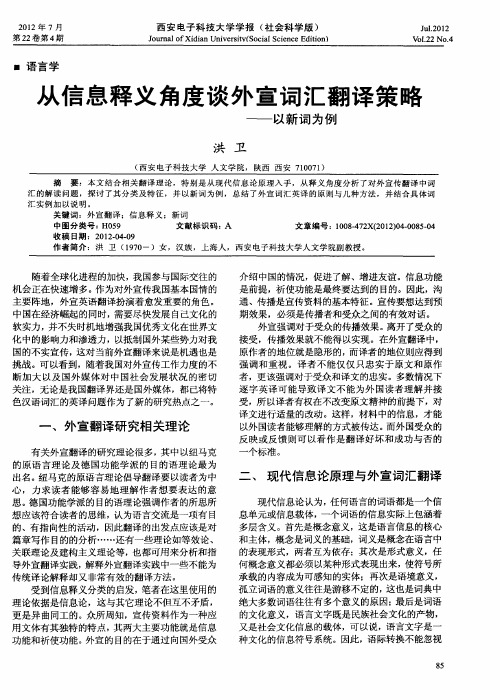
介绍 中 国的情况 ,促进 了解 、增进友谊 。信息功 能 是前 提 ,祈 使功能是最终要 达到的 目的。因此 ,沟 通 、传 播是宣传 资料的基本特征 。宣传要想达 到预 期效 果 ,必须是传播 者和受众之 间的有效对话 。 外 宣强调对 于受 众的传播效果 。 离开 了受众 的 接受 ,传 播效果就不 能得 以实现 。在外宣翻译 中, 原作者 的地位就是 隐形的 , 而译者 的地 位则应得 到 强调 和 重视 。译 者 不 能仅仅 只 忠实 于原 文和 原作 者 ,更 该强调对于 受众 和译文 的忠 实 。多数情况 下 逐字 英 译可 能 导致 译文 不 能为外 国读者 理解 并接 受 ,所 以译者有权在 不改变原文精 神的前提下 ,对 译文进行适 量 的改动 。这样 ,材 料 中的信 息,才 能 以外 国读 者能够理解 的方式被传达 。 外 国受众 的 而 反 映或 反馈 则可 以看 作 是翻 译好 坏 和成 功与 否 的 个标准 。
一 语 言 学
从 信 息释义 角度 谈 宣 外 词汇翻 译策 略
— —
以 新 词 为学院 ,陕西 西安 7 0 7 ) 10 1 摘 要 :本文结 合相关翻 译理论 ,特别是 从现代信 息论原 理入手 ,从 释义角度 分析 了对 外宣传翻 译中词 汇 的 解 读 问 题 , 探 讨 了其 分 类 及 特 征 , 并 以新 词 为 例 , 总 结 了外 宣 词 汇 英 译 的 原 则 与 几 种 方 法 , 并 结 合 具 体 词 汇 实例加 以说 明。 关 键 词 : 外 宣 翻 译 ;信 息 释 义 ;新 词 中 图 分 类 号 : 5 H0 9 文献标 识码 : A 文 章 编 号 :1 0 .7 X 2 1 )40 8.4 0 84 2 (0 20 .0 50 收稿 日期 :2 1 .40 0 20 .9 作者 简介 :洪 卫 ( 9 0 1 7 一)女,汉族 ,上海人 ,西安 电子科 技大学人文 学院副教授 。
谈谈新闻英语的“新词新语”及翻译

新 闻英 语 的 “ 词 ” 翻译 新 及 英 文 报 刊不 仅 是 报 道 新 闻 的 媒 介 , 而且 称 之 为 使 用 新词 的 庞大 机 器 和杜 撰 新 词 的 巨 大工 厂 。了解新 词 的 构 成方 法 . 将 对尽 快 掌 握 它们 的含 义 和 用 法 大 有 帮 助 。新 词 的构 成方 法灵 活 多样 . 常见 的 有 以 下几 种 。
一
6外 来 词 .
1派 生 词 .
派 生 词 是 把 词 根 与前 缀 或 后 缀 相 结 合 所 构 成 的新 词 . 是 新 闻英 语 中 最常 见 的 创 词 手段 。 , 如 在报 刊 上 较 为活 跃 的 后缀 有 :i 表 示 “ 视 ” : x m对 女 性 的歧 视 ;ws( 示 “ 一s m( 歧 )s i es 一i 表 e 在 方 面 ” :esn ly i ( ) p r a tws 在个 性 方 面 ) 较 为 活跃 的前 缀有 o i e 。 a t ( 示 “ 对 、 传 统 的 ” :ni u i ( 主 流 音 乐 ) n n ni 表 一 反 反 )at s 反 m c ;o 一 ( 示 “ 定 、 反 ” :o p li l非 政 治 的 ) 表 否 相 ) n n o t a( ic 。
… …
新 闻 英 语 词 汇 的 另 一 个 显 著 的 特 点 就 是 经 常 选 用 外 来 词 ,尤 其 是 在 新 闻 报道 中记 者 提 及 外 国 的或 新 近 出 现 的事 物 时 ,为 引起 读 者 的 兴趣 和注 意 .或更 贴切 地 表 达 某 词语 的 内 涵 , 种现 象就 更 为 突 出 , 些 外 来 语 由 于经 常使 用 , 这 有 已经 完 全 英 语 化 了 。如 ,e o an n g t ( 丁 语 ) p m n o r a 拉 a —— 不 受 欢 迎 的 人 , co ( t on 日语 ) — 巨头 , i h cu n汉 语 ) — 太 极 拳 。 y — t i ha ( ac — 二 、 闻英 语 的 “ 语 ” 翻 译 新 新 及
流行新词英译策略论文
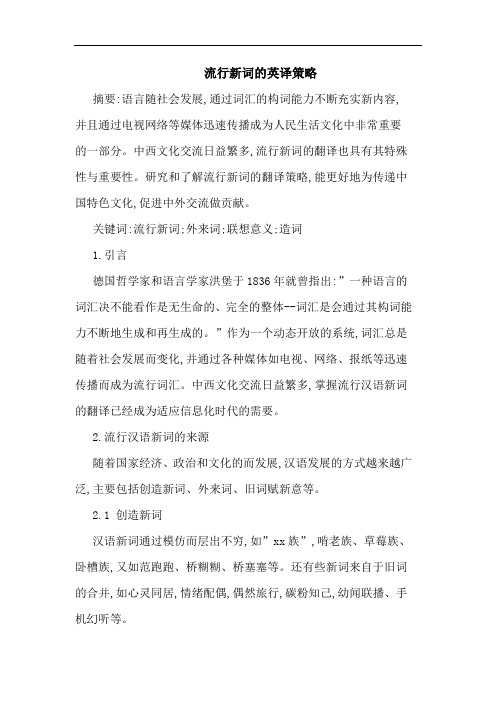
流行新词的英译策略摘要:语言随社会发展,通过词汇的构词能力不断充实新内容,并且通过电视网络等媒体迅速传播成为人民生活文化中非常重要的一部分。
中西文化交流日益繁多,流行新词的翻译也具有其特殊性与重要性。
研究和了解流行新词的翻译策略,能更好地为传递中国特色文化,促进中外交流做贡献。
关键词:流行新词;外来词;联想意义;造词1.引言德国哲学家和语言学家洪堡于1836年就曾指出:”一种语言的词汇决不能看作是无生命的、完全的整体--词汇是会通过其构词能力不断地生成和再生成的。
”作为一个动态开放的系统,词汇总是随着社会发展而变化,并通过各种媒体如电视、网络、报纸等迅速传播而成为流行词汇。
中西文化交流日益繁多,掌握流行汉语新词的翻译已经成为适应信息化时代的需要。
2.流行汉语新词的来源随着国家经济、政治和文化的而发展,汉语发展的方式越来越广泛,主要包括创造新词、外来词、旧词赋新意等。
2.1 创造新词汉语新词通过模仿而层出不穷,如”xx族”,啃老族、草莓族、卧槽族,又如范跑跑、桥糊糊、桥塞塞等。
还有些新词来自于旧词的合并,如心灵同居,情绪配偶,偶然旅行,碳粉知己,幼闻联播、手机幻听等。
2.2 外来词网络发展促进了世界文化交流,中国很多流行词汇来自外国。
外来词的产生通常是由于不同国家出现了相同事物或现象引用过来,如”宅”, 来自日本,形容整日呆在家里、依赖电脑且不喜户外活动的男女;”森女”两年前源于日本一个社交网站,指二十多岁、追求简单自然的生活方式的女孩子。
2.3 旧词新意新事物产生于旧事物基础上,与旧事物有共同之处,故很多流行词汇来自旧词新意。
如”囧”,原意指光明、明亮,像窗口通明,由于其字形像一张失望沮丧的脸产生了新意,表示郁闷悲伤,尴尬无奈等。
又如”马甲”,原指保护马的装具或人穿背心,现指网络论坛上一个人的不同id。
2.4 双关变化为了达到幽默风趣的效果,人们有时候会使用双关来达到预期效果。
如现在网络上非常流行的”锅”“杯具”“内牛满面”等。
新闻英语翻译中的词汇处理策略

21 年 3 01 月
M a . 0l r2 l
新 闻英 语 翻译 中 的 词 汇 处 理 策 略
罗 辉
( 湖南师范大学 外 国语学 院 ,湖南长 沙
[ 摘
40 0 ) 10 6
要]新闻英语 中众多的新词汇 、多义词 、习语 、谚语 等等 ,给译者 带来 了翻译上 的困难。新词
汇 的 翻 译 需要 译 者 根 据 词 的结 构 和 上下 文 的意 思 ,决 定 是 直译 、意 译 还 是 音 译 。多 义 词 词 义 的 确 定 , 要 依 靠 词语 出现 的 上 下 文语 境 、文化 语 境 、情 景 语 境及 主题 等 因 素 。引 申词 的 词义 则 要 从 原 词 的 内 在
[ 作者简介]罗 辉(9 1 , 湖南师范大学外 国语学院讲师 , 17 一) 男, 硕士研 究生, 从事英语翻译 、 中西文化及教 学论研 究。
・
10 ・ 3
多 ,比如 “ E ”就 比 “ 行总 裁”要 简单 。正 因如此 ,才会 有越来 越多 的英 文 词汇 出现 在 汉语 中 ,不 管 它 CO 执
翻译 中对词 义的理解 是非 常重要 的。我们 需要根据 词语 的上 下文 ,其本 身 的搭配 ,它所 体现 的内涵 、联想意
义 ,反映 出的情感 ,或者文化 背景来理解 。
翻译 的过程 中 ,是用 异化 ( r tz in f e ̄ i t )手段 ,也 且 直 译 ,还是 归化 (o et ao )手 段 ,也 即意 译 ? o i ao H dm s ctn i i 是增添 、加 注还 是删减 ?是原文 照搬还是借 用原语 ?在 词汇 翻译 中 ,这些 都是要 思考 的问题 。
以采用 已经普遍 接受 的译 文 ,比如 “l —r ”( b e a 蓝光光盘 ) u y 。也可 以采用类 推法 ,比如 “ —m i e a”是 “ l 电子 邮件” ,那 么 “ 一 n s e u”可 以译 为 “ 电子菜单 ” 。有些新词 第一 次出现 ,就 需要译者 根 据词 的结 构和 上下 文 的意思 ,决 定是直译 、意译 还是音译 。但不管 怎样翻译 ,都 要符合译 语 的表 达习惯 ,也要符合 原文 的意思 。 在科技 迅猛发 展的今 天 ,汉语 的 “ 纯度 ”也 受到 了外语 的影 响。有很 多英 文表示 的东西 现在很 少有人使
浅析英语新词的产生,构成及翻译方法

校园英语 /浅析英语新词的产生,构成及翻译方法天津外国语大学/张夕【摘要】近年来,英语中涌现出许多新词新义,本文着眼于英语新词产生的原因,以及新词的构成和翻译方法三个方面,对英语新词进行梳理与总结归纳,以其寻找出相应的规律,为以后英语词汇的扩充提供借鉴。
【关键词】英语新词 构词法 翻译策略一、前言随着经济全球化的不断发展,英语在世界范围内广泛传播,对世界各国的文化发展产生了重大的影响。
尤其是在近些年,由于网络的普及,以及网络语言的发展,英语也在根据社会发展与自身语言发展的需求不断创造新的词汇。
因此作为一名英语翻译人才,对英语新词的掌握与翻译也就成为英语学习中的应有之义。
二、英语新词产生的原因1.科学技术的巨大进步。
二战结束后,世界范围内科技发展取得了巨大的成就。
科技就意味着创新,随着数学,化学,物理,军事,天文等各个领域的不断发展,各种新物质被发现,各种新鲜事物被创造,急需大量的英语新词来进行定义。
2.社会政治经济与文化的发展。
只要有人类存在,文明便将持续下去,语言文字作为文明产生的标志,就必然要随着社会的不断发展产生各种各样的新词。
各国政治风云变幻,各种政治口号的提出,从冷战的两极分化到新时期的一超多强;经济上从凯恩斯主义到新经济与自由主义;各种文化流派的不断发展,意识流,后现代主义等等。
这些活动都创造出了许许多多的新词新义。
3.旧词新义与其他语言的影响。
英语是一种充满活力的语言,具有十分强的包容性。
随着人类社会的不断发展,许多旧词需要加入新的含义。
与此同时,英语作为一种世界语言,在与他国的文化交流中受到其他语言的影响,必然会产生许多新词。
三、英语新词的构词法1.创新法。
所谓创新法,就是完全创造出一个新的英语词汇,这种方法在英语新词中与其他的构词法相比使用的较少,但是也是不容忽视的。
使用创新法创造的词汇有:(1)Selfie 自拍。
Selfie就是“自拍照”,尤指那些自拍后上传到社交网站的照片。
《2024年译者主体性视角下汉英口译中时政新词翻译研究》范文

《译者主体性视角下汉英口译中时政新词翻译研究》篇一一、引言随着全球化进程的推进,政治交流和经济合作日趋频繁,汉英口译中的时政新词翻译愈发重要。
在跨文化交际的背景下,译者的主体性发挥着重要作用。
译者不仅需对原语和目标语进行准确的解读,还需要将原文与当前的社会文化背景、政治经济环境相结合,进行时政新词的翻译。
本文将从译者主体性视角出发,探讨汉英口译中时政新词的翻译策略和技巧。
二、译者主体性在时政新词翻译中的重要性译者主体性指的是在翻译过程中,译者所具备的主动性、创造性及自我认知的能力。
在汉英口译中,特别是在时政新词的翻译中,译者的主体性发挥着至关重要的作用。
译者需要结合自身专业知识、语言能力和对时政新词的敏感度,将复杂的政治词汇准确、简洁地翻译为英语,使听众能够理解其含义。
三、汉英口译中时政新词的翻译策略1. 直译法:对于一些具有明确含义的时政新词,可以采用直译法进行翻译。
例如,“一带一路”可以直译为“One Belt One Road”。
2. 意译法:对于一些抽象或具有文化内涵的时政新词,可以采取意译法进行翻译。
如“全面深化改革”可以翻译为“to comprehensively deepen reform”。
3. 借用法:借鉴已有的英文表达方式来翻译时政新词。
如“绿水青山就是金山银山”可借鉴英语中环保概念的表述,译为“Green mountains and clear waters are our greatest asset”。
四、译者应具备的素质与技能1. 丰富的专业知识:译者应具备扎实的政治理论知识和良好的语言表达能力,以便准确理解并翻译时政新词。
2. 跨文化意识:了解中西方文化的差异和历史背景,避免在翻译过程中产生歧义或误解。
3. 敏感性和创造性:对于未知的或难以直译的时政新词,译者需要运用敏感性和创造性思维进行准确、简明的翻译。
五、结论本文从译者主体性视角出发,探讨了汉英口译中时政新词的翻译策略和技巧。
《译者主体性视角下汉英口译中时政新词翻译研究》范文
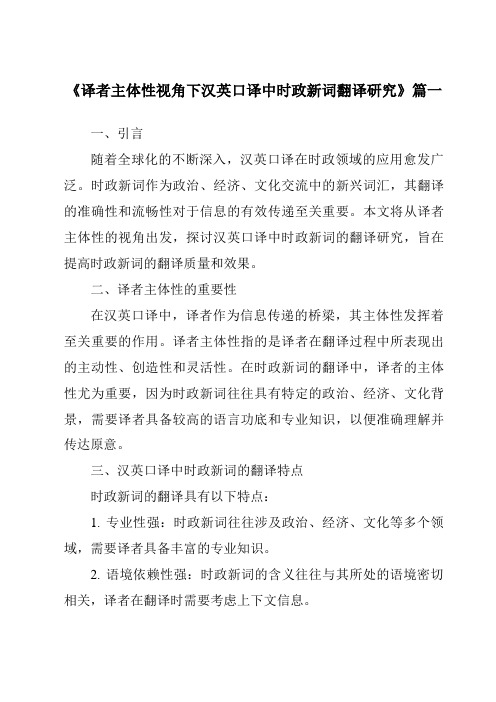
《译者主体性视角下汉英口译中时政新词翻译研究》篇一一、引言随着全球化的不断深入,汉英口译在时政领域的应用愈发广泛。
时政新词作为政治、经济、文化交流中的新兴词汇,其翻译的准确性和流畅性对于信息的有效传递至关重要。
本文将从译者主体性的视角出发,探讨汉英口译中时政新词的翻译研究,旨在提高时政新词的翻译质量和效果。
二、译者主体性的重要性在汉英口译中,译者作为信息传递的桥梁,其主体性发挥着至关重要的作用。
译者主体性指的是译者在翻译过程中所表现出的主动性、创造性和灵活性。
在时政新词的翻译中,译者的主体性尤为重要,因为时政新词往往具有特定的政治、经济、文化背景,需要译者具备较高的语言功底和专业知识,以便准确理解并传达原意。
三、汉英口译中时政新词的翻译特点时政新词的翻译具有以下特点:1. 专业性强:时政新词往往涉及政治、经济、文化等多个领域,需要译者具备丰富的专业知识。
2. 语境依赖性强:时政新词的含义往往与其所处的语境密切相关,译者在翻译时需要考虑上下文信息。
3. 创新性高:时政新词的出现往往代表着新的思想、观念或现象,需要译者具备创新意识和敏锐的洞察力。
四、译者主体性在时政新词翻译中的应用在汉英口译中,译者主体性的发挥对于时政新词的翻译具有以下作用:1. 提高翻译准确性:译者通过主动学习相关知识,提高自身的专业素养,从而准确理解时政新词的含义。
2. 增强文化意识:译者需具备跨文化意识,了解中西方文化的差异,以便在翻译时政新词时传达出原文的文化内涵。
3. 灵活运用翻译策略:根据时政新词的特性,译者需灵活运用直译、意译、音译等翻译策略,以实现翻译的准确性和流畅性。
五、实例分析以“一带一路”为例,该词在汉英口译中的翻译体现了译者的主体性。
译者需要准确理解“一带一路”的内涵,包括其政治、经济和文化意义。
在翻译过程中,译者采用了意译的策略,将“一带一路”翻译为“the Belt and Road Initiative”,同时辅以适当的解释,以便让听众更好地理解其含义。
- 1、下载文档前请自行甄别文档内容的完整性,平台不提供额外的编辑、内容补充、找答案等附加服务。
- 2、"仅部分预览"的文档,不可在线预览部分如存在完整性等问题,可反馈申请退款(可完整预览的文档不适用该条件!)。
- 3、如文档侵犯您的权益,请联系客服反馈,我们会尽快为您处理(人工客服工作时间:9:00-18:30)。
论新闻英语词汇中新词的翻译策略On the Translation Strategy of Neologisms in Journalistic Eng-lish VocabularyAbstractAs the society and the progress of the times, the modern emergence of a large number of English vocabulary, and most of these new things and new expression first to appear in English news. Journalistic neologisms not only introduce the newly emerging things, phe-nomena and experience in a vivid way, but also enrich our daily vocabulary, enhance our ability to express.Neologisms are especially usefuly in identifying inventions, new phenomena or old ideas which have taken on a new cultural content; they have close relationship with partic-ular political and social backgrounds; they are coined and used to arouse public attention and interest. A neologism may arise from word formation, borrowing words from other languages, or old words with new meanings.The language in English news is interesting to understand, simple refining, strong in expression, vivid narrative, So, translation of the news must be more tempered in the wording to reflect the total apperance of journalistic English. In the light of translatology and linguistics, the paper bases on Newmark’s major contribution--- the dichotomy of communicative vs. semantic translation theory in the translation of journalistic English, the paper focuses on some translation strategies on English journalistic neologisms and its translation.Key Words: neologism, Newmark’s translation theory, translation strategy内容摘要随着社会和时代的进步,现代英语中出现了大量的词汇,这些表达新事物和新概念的英语新词新义大多率先出现在英语新闻中。
新闻新词是介绍新生事物,体现新的现象,丰富我们的日常词汇,增强我们表达能力,表现新的文化内容和经验的一个生动的方式。
新词总与特定的政治和社会背景有密切联系,它们的创造和使用能引起公众的兴趣和关注。
新词可以通过构词法形成,从其他语言借用或是从旧词的意义引申转化而成。
新闻英语语言有趣易懂,简洁精炼,表达有力,叙述生动,翻译时就必须在用词上多加锤炼,才能体现新闻文体的总貌。
作者借助于翻译学和语言学,以纽马克的“交际翻译理论”和“语义翻译理论”为依据和指导,并将翻译理论和英语汉译实践相结合,用新闻翻译的实例分析新闻英语中新词的构词特点和翻译策略。
关键词:新词;纽马克理论;翻译策略ContentsIntroduction (1)1. A Brief Survey of the Newmark’s Theory (3)2. Studies of the Source of Neologisms (5)3. Formation of English Neologisms (6)3.1 Word Building Formation (7)3.2 Semantic Neologism (9)3.2.1 Borrowings (9)3.2.2 Old Words With New Senses (10)4. Translation Strategies of Newspaper Neologisms (11)4.1 Equivalent Translation (11)4.2 Back-translation (13)4.3 Literal translation (14)4.4 Free translation (16)4.5 Transliteration (18)Conclusion (21)Notes (24)Bibliography (25)Acknowledgements ............................................................................. 错误!未定义书签。
IntroductionNewspaper is considered as an effective channel for people to know the outside world. Through reading newspaper, people can be informed of the current events happening all around the world, get aquaintance with the per-formance of a new policy, and are provided with a colorful life owing to a va-riety of entertainment in the newspaper. As we know, all the novel phenomena require something new to name them, which gives rise to birth to neologisms. And then the neologisms make their way into mass media such as newspapers to be spread and popularize d among people. In Oxford Advanced Learner’s English—Chinese Dictionary, a neologism is “a new world or expression or a new meaning of a word”①As the most active part in language,vocabulary always reflects the changing of society and life. From words we can know social development,emergence of new things and so on,which can also be clearly observed in news writing. Take for example English words like “super”, “cool”, “VIP”“environmentalist”, “quality time” and “Dink”. Many of them are short-lived and some are nonce words, which appear and spread so soon before they va-nish from our sight that we could hardly notice their existence. There are some lucky ones that can find their way into the common vocabulary. At any rate these neologisms are really capable of catching readers' eyes immediately,often on account of their special characteristics or meanings. In addition, they will not only generate readers' interest but also contribute to the readability of a newspaper. So the news translation inevitably plays an important role in in-formation communication.Many language workers are taking efforts in the translation of neolog-isms since the appearance of many neologisms has aroused the great interest at all levels and these neologisms are appealing timely translation. Quite a number of works related with the translation of new words have been pub-lished during the recent years. However, all of these works didn't give an overall introduction of the creation of neologism as well as its translation; neither make analysis of some consequences of the use of new words and ex-pressions in daily life. This paper, based on the abundant materials about neologism, includes a comprehensive introduction of neologism in English news vocabulary and focus on some strategies of how to translate neologisms into Chinese.The study on English neologisms is an arduous and continuing task. It keeps in touch with the most active and unstable part of the de-velopment of a language, so the research on it is standing on the frontier of the word revolution and facing the challenges brought require-ments of inter-translation between two languages. No in by the mater what happens, new words and expressions keep rising and the translation needs tocontinue. This everlasting activity provides a wide rangeof topics the study to of research and results in epoch making significance for translation theories.1. A Brief Survey of the Newmark’s TheoryPeter Newmark, a famous theorist and professor of Polytechnic of Cen-tral London made an important contribution to the study of translation theory. His major contribution is the dichotomy of communicative vs. semantic translation in his Approaches to Translation written in 2001. "Communicative translation attempts to produce on its readers an effect as close as possible to that obtained on the readers of the original. Semantic translation attempts to render, as closely as the semantic and syntactic structures of the second lan-guage allow, the exact contextual meaning of the original"②. He made con-trastive analysis from the following aspects:(1) Communicative translation addresses itself solely to the second read-er, Semantic translation remains within the original culture and assists the reader only in its connotations if they constitute the essential human mes-sage of the text.(2) Communicative translation must emphasize the `force' rather than the content of the message. Semantic translation would be more informative butless effective.(3) A semantic translation is always inferior to its original, since it in-volves loss of meaning; Communicative translation may gain enforce and cla-rify what it loses in semantic content. The translator is trying in his own lan-guage to write a little better than the original③.The center of communicative translation is force of information and reader; while semantic translation focuses on meaning and author. Although these two kinds of translation have obvious difference, they "may well coin-cide in particular, where the text conveys a general rather than a culturally bound message and where the matter is as important as the manner"④. And they both comply with the usually syntactic equivalents for the two languages. That is to say, a translation can be more or less semantic, or more or less communicative, but without complete division."Original expression, where the specific language of the speaker or writ-er is as important as the content, whether it is philosophical, religious, politi-cal, scientific, technical or literary, needs to be translated semantically"○5. Up to now, it is obviously clear that journalistic English belongs to informative text, whose proper translation should be "communicative translation" there are also many original expressions (political speech of government some im-portant figures, etc) quoted by the reporter and they need semantic translation. Therefore, both "communicative translation" and "semantic translation" aresuitable for news translation.2. Studies of the Source of NeologismsNeologisms have close relationship with particular political and social backgrounds; they are coined and used to arouse public attention and interest. More studies have been carried out on the source of neologisms.Zhang Yihua⑥summarizes three major sources: the development of science and technology, the development of information technology, inherit-ance and creative power of language in its process of development. Zhao Lizhu⑦holds that economic development is one of the important sources of new words. Wu Gang⑧adds that politics provides many new words to Eng-lish. For example, "Iraqphobia"(伊恐症)is coined as a result of the Iraqi War. "-gate" from "Watergate" has become a suffix indicating "political scandal".In the ever-developing society, science and technology is the main sup-plier of new vocabulary. Today, if you don't know anything about "blog", you are sure to have fallen behind. "Blog" is the short form of "web log". Web logs have come of age. "Blogosphere" is the realm of the "blog". "Bloggers" take on a prominent role in vetting the mainstream media.Many neologisms, such as prime time(黄金时间), talk show(脱口秀),blockbuster(火爆),boomed with the popularization of TV and radio. Manysocial problems can also come along with lots of neologism. For example: DINK (an acronym for "couples with dual income and no kids”丁克家庭).3. Formation of English NeologismsIn the recent 20 years, English vocabulary has increased in quantity and in extent, mainly by changing word form and changing word meaning. Peter Newmark gives a definition in his works A Textbook of Translation: “Neo-logisms can be defined as newly coined lexical units or existing lexical units that acquire a new sense.”He holds the opinion that "new objects and processes are continually created in technology. New ideas and variations on feelings come from the media. Terms from the social sciences, slang, dialect coming into the mainstream of language, transferred words, make up the rest." From Newmark's definition, we are able to make two basic points about a neologism. It could be a newly created linguistic form from a linguistic point of view. Or, from a semantic point of view it could be an old form that has existed for quite a long time but a new meaning is attached to. His state-ment also makes it clear that a neologism may arise from new things and me-thods, or from fresh ideas and emotions and that a neologism can originate from science and technology, foreign languages as well.⑨3.1 Word Building FormationIn the course of word revolution, various methods of word formation re-sult in numerous new words and then these newcomers of word stock present the prevailing and practical methods of word-building. As a good mirror to display the laws of vocabulary development, this dynamic process facilitates language workers to learn more about the up-dated trend of word revolution and induct prevailing ways of new word creation so as to direct the appropri-ate utilization of neologisms and enrich the expressions of language.(1) CompoundingCompounding, also called composition, is characteristic of flexibility, changeability and dynamism. A compound is a lexical unit consisting of more than one stem and functioning both grammatically and semantically as a sin-gle word. “Silkworm” and “e-mail” are compounds; so are “bungle jumping” and “home page”.(2) AffixationAffixation is composed of prefixes and suffixes. Among the new prefixes were born over the last decades, eco- is an active one, we have been familiar with the words, such as ecosystem(生态系统),eco-catastrophe(生态灾难),etc. In recent years, eco-efficiency(生态效率)is attracting people's attention. It means maintaining the stable economic development without destroying the environment.(3) AnalogyAnalogy is a method of inventing new words through imitating words and phrases frequently used. New words and phrases can be based on the si-milarity in form between the old and the new.In 1960s, the word "sit-in" was used in the anti-racial movement by the Negroes. It was translated as“室内静坐”.Later, a lot of similar words ap-peared in the local newspapers, such as: ride-in(黑人与白人同乘一车),swim-in(到白人游泳池游泳), read-in(进入白人图书馆阅读),pray-in(进入白人教堂做礼拜).(4) BlendingBlending is mixing together parts of two or more words. For example: autocide (automobile + suicide撞车自杀),videophone (video + telephone 电视电话),medicare (medicine+care老年保健医疗制度),telescript (tele-vision +script电视广播稿),psywar (psychological+ warfare心理战).5) ShorteningShortening is composed of clipped words(缩短词)and acronyms(首字母缩略词) Clipped words are re-formed after cutting some part off the original words, such as: “Phone”(telephone), “ad”(advertisements), “fridge”(refrigerator), and “coke”(coca cola). The most typical example of acronym is “AIDS”(=acquired immune deficiency syndrome). Other exam-ples include CNN (Cable News Network), SOHO (=Small Office, Home Of-fice)3.2 Semantic NeologismExamining English vocabulary in its historical perspective, we can see that English is characterized by a marked tendency to go outside her own lin-guistic resources and borrow from other languages. We often encounter fa-miliar words amid the vast number of strange ones. These words are new not in form but in meaning. To extend the meanings of a word is also an impor-tant way of producing neologisms.3.2.1 BorrowingsEnglish is characterized by a marked tendency to go outside her own linguistic resources and borrow from other languages. It is quite receptive to foreign linguistic influence. It is estimated that English borrowings constitute 80% of the modem English vocabulary, among which 26.4% borrowings come from French, 15.8% from Latin and the rest from various sources around the globe○10. Although this borrowing has slowed down, it is still an important factor in English vocabulary growth. And among them are Chinese borrowings, though they account for a small part only. Such as the followingexamples:Diagram 1:These words are often appeared in oversea newspapers, and some of them were collected into authoritative English dictionaries.3.2.2 Old Words With New SensesActually, old words with new meanings is a common phenomenon in language. The words which were used previously may now carry a fresh meaning and stand for a new thing. They will increase both in the number and in the range as well. For example,the term "hotline" was first made the headlines in the early 1960s, when it was applied to the direct telephone link between the US and Soviet governments, serving as an aid to mutual under-standing in times of international crisis. However, when one needs any help, advice and even a heart-to-heart talk today, he may take advantage of a hot-line, a direct, exclusive communication channel linking to his desired radio host or hostess,etc. Other examples include in diagram 2:diagram 2:4. Translation Strategies of Newspaper NeologismsNew Mark holds the opinion that "Neologisms are perhaps the non-literary and the professional translator's biggest problem." So the transla-tion of news-style neologisms is a hard nut to crack. He also stated that "one cannot standardize the translating of a neologism when its future is in doubt.○11 " His statement clearly points out the impossibility to find any recognized terms for neologisms in the news translation. Nevertheless, as a matter of the whole, the rendering of a neologism in newspapers has to observe the prin-ciples of news translation, for they are part of a piece of news reporting. Faithfulness to the content and style of the original and naturalness in lan-guage will be the fundamental guidelines for translating news-style neolog-isms. At the same time, timeliness and effectiveness may have to be guaran-teed.4.1 Equivalent TranslationSome neologisms are created according to the rules or methods of word formation. Although they do not present any character of words in other lan-guages, we can find their equivalent or most equivalent translation in other languages. This is because people in different regions share the same informa-tion all over the world and they can make a lot of agreements despite the great difference between languages.Equivalent translation can transfer the source-language message directly into the target language when the two languages point to the same meaning. Therefore, news readers will not have any obstacle in understanding, which caused by language barrier. In another aspect, equivalent translation is the ea-siest way because it is equivalent in the form and in the content as well. But the prerequisite of this way is that both the source language and the target language have the same understanding and interpretation for the same con-cept.In practice, people do follow this principle much to translate new word and expressions.For example:Mexican telecoms tycoon Carlos Slim came in second with an estimated worth of $60 billion, pushing Gates to third place after 13 years of holding the No. 1 spot. In this piece of news, ‘tycoon’is from the Chinese language meaning“A wealthy and powerful bussinessperson or industrialist”.Nursing is not a n ine-to-five job with every weekend off. Here‘nine-to-five’is a popular term used to describe the average day job withhours from 9 a.m. to 5 p.m. This quite conforms to office working hours in China, and we has such a term as“朝九晚五”to describe the working hour system.4.2 Back-translationSince China's opening to the outside world, a great number of foreign neologisms have entered into Chinese vocabulary and most of them have be-come popular with the Chinese. Sometimes, people discover that these new words and terms are not originated in their native language, but borrowed from other languages. These new expressions come into force due to the new ideas and concepts originating in other countries.However, most of people get more acquainted with the ones in their na-tive language than in foreign languages. In translating these foreign borrow-ings, it is advisable to adopt the back-translation, i.e. to translate back straight to their originals. Say, the recent transliterated English words like “酷”,“黑客”,“雅虎”,and“伊妹儿”all can be immediately transferred back to "cool", "hacker", "Yahoo" and "e-mail" respectively.Another instance is the version of“千年虫问题”,which refers to "the inability of certain computer software to deal correctly with dates later than31 December 1999, threatening to bring computer's systems worldwide crashing to a halt at the arrival of the millennium". Also sometimes referred to as the "millennium bomb". There is a report on this in 1996 Times: "The In-ternal Revenue Service envisages taking 300 man-years to defeat the‘new millennium bug’”. Therefore, it is wrong to come up with the English version of "the problem of millennium bug" for the term“千年虫问题”.In fact, lots of words can be back-translated, for the examples in diagram 3:diagram 3:From the above examples, it is not difficult to find that back-translation is particularly advantageous in translating those words and expressions com-ing from foreign languages. Hence, back-translation is a process of returning neologisms to their original forms.4.3 Literal translationLiteral translation is considered to be the basic translation procedure, both in communicative and semantic translation. It is the practical applica-tion of Newmark's "semantic translation", emphasizing on the exact expres-sion of the original. That is to say, if possible, translate the literal meaning. It is the most perfect way to translate the source language into the target lan-guage is to keep the form and content in accordance with the original lan-guage.Word-for-word translation can be applied to translate the new ones under the conditions that the context provides the feasibility and the translation is capable of maintaining not only the content of the original but also the cultur-al connotation, rhetoric effect and semantic representations. Chinese language is so plentiful in number of vocabulary that it has more choices in picking up Chinese characters and tries to give the English words and expressions the Chinese-like translations as its native terms. We have translation for many words and phrases such as: euthanasia(安乐死),globalization(全球化), gen-eration gap(代沟), white-collar workers(白领工人) and so on. Literal translation makes a great contribution to Chinese borrowing from English be-cause it conforms to the characteristics of Chinese language structure and ex-poses clear meaning. Thanks to these features, words by literal translation are easy to be understood and accepted in Chinese and then innumerable new words and phrases are given rise to.English-readers even made creations on the translation loans so as to enrich English word stock and diversify ways of expression. For instance,"Dragon-boat Festival" is getting international attention and English-speakers take use of this translation loan to create "dragon-boaters": "The Chinese Cultural Association posted notice of Canada's first dragon-boat festival...less than a decade later, there are estimated to be more than 8,000 dragon boaters in Canada."○12In this sentence, competitors in dragon-boat racing are called "dragon-boaters". It is a creation by adding English affix to a Chinese transla-tion loan.Owing to its derivation characteristics, English can make more new words. This kind of derived words has gained support from another example "Chinese Wall": "The bank said it had been unaware of the holding which un-til disclosed put it in breach of the Companies Code, due to a Chinese Wall in communications within the bank."○13. Derived from "the Great Wall of China", "Chinese Wall" means an insuperable barrier of convention within a financial institution, business organization, etc.4.4 Free translationFree translation refers to the translation that is faithful to the original meaning, but has some originality on the form. The spirit of Newmark's "communicative translation" can be well reflected in this method. For exam-ple, sports bar(播放体育比赛电视的酒吧),physically challenged(身体有残疾的),skell(无家可归者), heliskiing(乘坐直升飞机上山的滑雪运动),etc.Free translation usually includes noun phrases, compound words, and words with stems and suffixes. Even a short sentence can be borrowed through free translation. "People mountains" "people sea" was from Chinese “人山人海”. Some neologisms, with strong cultural characteristics, can hardly be literally translated into the target language. Free translation should be used to represent the original meaning in the target language thanks to its more flexibility. On the premise of transmitting the original information, free translation breaks through the restriction of language structure and produces in the target language the more acceptable translation for the receptors."For a professional translator what counts is the effective transfer of the meaning because that is precisely what clients want and need○14". Free transla-tion is the most frequently-used technique in dealing with two languages. Sometimes, the meaning of words and phrases cannot be told from their literal meaning. Depending on complete understanding, free translation can be taken good use of. For example, "sandwich course" may make one confused about what it stands for. With more learning about the cultural background, it is known as the course alternating teaching with practice. So it can be translated as“教学与实习相间的课程”.Free translation is an active element in translating new words and ex-pressions: “It's a frigid Des Moines Sunday afternoon and the daughter of theupstart Republican presidential candidate is holding court in her new corner office above the campaign's Iowa headquarter s.○15”Here“upstart”means “a person who has suddenly risen to a higher economic status but has not gained social acceptance of others in that class.”Many Chinese readers know English expressions "upstart" and "new rich" are equivalent to Chinese“暴发户”.Factually, "money bag" and "jumped-up people" are wonderful portrayal of the same meaning as well.English newspapers also prefer rhetoric description that creates vivid image for the objects. It is not hard to find out the translation as long as the exact meaning is acquired. For instance, "windfall profit" is the same as "ex-cessive profit" and "sudden huge profit" (暴利)which means“profit that oc-curs unexpectedly as a consequence of some event not controlled by those who profit from it”, it uses metaphor to create a much better expression than the ordinary ones.4.5 TransliterationTransliteration is a way to borrow the phonemic with more or less subs-titution of native phonemes, to refer to the same object or idea it represents in the donor language. Transliteration is easy, direct and full of exotic flavor. Quite a number of transliterations keep alive after the wide spread over times. When readers are not eager to seek any other translation names for them, thetransliterations are kept in their minds. News readers come to realize the defi-ciency of transliteration after they learn more about the inner meaning, and they would substitute better translations for the transliterations.For example: Among other transgressions, the site's home page displays mistakes by German TV stations in which Nepalese police, shown in videos rounding up Tibetan protesters in Kathmandu are identified as Chinese. Here "Homepage", initially transliterated as“烘焙鸡”,caused difficulty of under-standing and finally was put into“主页”, the opening page of a web site. It shows that some transliterations are inexplicable and awkward-sounding but their free translations are explicit and easy to bear in mind. On the other side, some transliteration can stand the times and keep living till now so that their transliterations and free translations are leg and leg. As a matter of fact, trans-literation is giving its full play in translating trademarks. Take“可乐”. It has become a proper name for a kind of sweet drink and shares the good reputa-tion with tea and mineral water.Some linguists show preference to the importation of phonetic loans for the following reasons: convenience in need-filling, precision in expression and avoidance of ambiguity, desire for novelty, and quite academically, the helpful trace for etymology. There is a saying which goes "something national can be internationalized". We may sense the pulse of borrowing development by studying some Chinese loans in English media.In recent years, more westerners prefer the use of "tai chi"(太极) to "shadow boxing", "mantou"(馒头) to "steamed bread", "qipao"(旗袍) to "cheongsam", and "putonghua"(普通话) to "mandarin Chinese".The above citations show a tendency of introducing foreign things by giving their original phonemic shape, which is a way of alienating the cul-ture-loaded loanwords. That complete transliteration flourishes perhaps re-sults from the fact .that it is the method of least resistance a speaker or writer may take when faced with a gap or inadequacy in the vocabulary. Instead of making a creative effort of some kind, one can simply take over a suitable word from other languages.News report is closely related to figures, events, time and place.According to TanWeiguo’s research of 40 news leads in the New York Times, proper names nvolved amount to 598 words, according for about one third of the total number 1865.○16Transliteration is a main technique in trans-lating some proper terms such as people's names and place names. When we use this technique, some points should be taken into consideration:(1) To avoid a long translation, some phonemes that cannot be heard ap-parently in the English words need not to be translated. For instance: Engels 恩格斯(instead of 恩格尔斯), Elizabeth伊丽莎白(instead of伊丽莎白丝) etc.(2) To avoid the forming of a misleading concept, some Chinese charac-。
